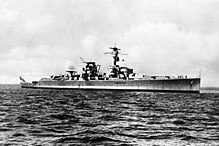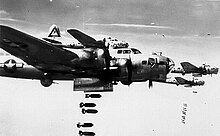Air raid on Swinoujscie


The air raid on Swinoujscie took place on March 12, 1945, a few weeks before the end of World War II . It was Swinoujscie by a massive air strike all three bomber divisions of the 8th Air Force largely destroyed. The number of - mostly civil - fatalities was considerable. The Red Army , which was standing in front of the island of Wollin , had asked the allies for support, as the further advance to the west was proving difficult.
Starting position
As a naval base, Swinoujscie was the most important station on the sea route between the Eastern Front and Kiel. The military port was protected by the Swinoujscie fortress , which remained largely intact until the end of the war. In addition, the Swinoujscie station was on the railway line along the Baltic Sea coast. On March 7, 1945, Kampfgruppe 2 of the Kriegsmarine, consisting of the armored cruisers Admiral Scheer and Lützow as well as several destroyers and torpedo boats, was moved from Gotenhafen to the military port of Swinoujscie. There were also twelve transport ships with which the Kriegsmarine, following the Hannibal company, evacuated refugees from East Prussia on the way back from the approaching Red Army as part of the supply logistics for the troops at the front . The overland route via Swinoujscie was also considered to be one of the last reasonably safe routes for people to escape by road or rail from the basins in Pomerania and West Prussia ( Oxhöfter Kämpe , Hela , Danzig , Köslin and Kolberg ), so that the city was full of refugees . The Red Army had made a breakthrough at Stargard at the beginning of March 1945 , but its advance near Wollin met with strong resistance from the Wehrmacht. The heavy naval artillery of the combat group stationed in Świnoujście posed a serious threat to the Soviet troops operating near the coast. To relieve the burden, the Soviet Union asked its western allies to attack the logistical infrastructure of the enemy and also its capital ships on the Baltic coast.
The attack


The attack began shortly after 12 noon and lasted about an hour. It was carried out by 661 heavy, four-engine bombers ( B-17 "Flying Fortress" and B-24 "Liberator") and 412 escort fighters. The visibility favored the mission, as the fire from the heavy German anti-aircraft batteries remained largely ineffective, but also made aiming more difficult. The bombers dropped 1,609 tons of bombs, mostly high explosive and cluster bombs, from a height of around 6,000 meters.
consequences
Property damage
The attack caused serious damage or total loss to some floating units in the port, but it failed to achieve its goal of rendering the Swinoujscie naval base unusable. Also, none of the larger combat ships had been hit because they were not in port at the time of the attack. Only two torpedo boats had suffered slight damage. The transport ships Jasmund , Hilde , Ravensburg , Heiligenhafen , Tolina , Cordillera and Andros , however, were sunk.
Larger parts of the city center were largely destroyed, the suburbs and the area of the spa gardens were also hit by the bomb carpets. The degree of destruction of the city by this attack is given as 55%
Casualty numbers
There are different numbers of victims of the air strike among refugees and residents:
Initially, there are two German reports of loss or damage from the two days after the attack, each of which named 1,500 deaths. On March 13, 1945, the commander of the Ordnungspolizei (BdO) Stettin reported: Loss of persons so far: 1500 dead, 1000 of them on the steamer 'Andros', 2000 wounded . The air force command reported: So far 1,500 dead, 2,000 wounded. However, the determination of the number of victims was made more difficult by the fact that the number of refugees in Swinoujscie at the time of the attack was not precisely recorded beforehand, as the authorities were overwhelmed by the mass of refugees or they were not registered as travelers in any case. Since many of the victims were badly disfigured by the bombing, numerous dead could no longer be identified.
In the scientific literature z. B. Rolf-Dieter Müller from the Military History Research Office 3,000 to 4,000 dead, Helmut Schnatz comes to 4,500 dead in his monograph on the attack. The Volksbund Deutsche Kriegsgräberfürsorge states a number of at least 4,500 dead.
The number of 23,000 deaths, which is sometimes circulating in the media, describes Müller as unsustainable. Schnatz also rejects the number, particularly pointing out that such a number of deaths is unrealistic in terms of the explosive force used and measurements of the cemetery facilities clearly showed that the designated space for this number is far from sufficient. However, the mass graves of the Golm were partially protected by pine trees during the GDR era, and the war cemetery on the Golm is not the only place of burial. Other dead were buried in the already existing cemeteries in Swinoujscie and in the area east of the Swine. Some of the people buried remained under the rubble of the city. The dead recovered by the Andros in 1948 were not buried on the Golm either.
Culture of remembrance
The majority of the recovered dead were buried in mass graves on the nearby Golm near Kamminke . At 69 meters, the Golm is the highest point on the island of Usedom. Świnoujście itself is so deep that it was not possible to create mass graves because of the high water table. As a result of the new demarcation (Swinoujscie has been part of Poland since 1945 and has been called Świnoujście since then ), the air attack did not penetrate the public consciousness for a long time. On March 12th of each year, memorial events for the victims of this attack take place in the memorial on the Golm, which remained on the German side of the new border.
See also
literature
- Norbert Buske : The cross on the Golm. Politically owned war graves . State Center for Political Education Mecklenburg-Western Pomerania. Regional studies booklets. Schwerin, Helms-Verlag 1995. ISBN 3-931185-01-X
- Roger A. Freeman: Mighty Eighth War Diary . JANE'S, London, New York, Sydney 1981. ISBN 0-7106-0038-0
- Helmut Schnatz : The air raid on Swinoujscie - Documentation of a tragedy . FA Herbig, Munich 2005, ISBN 3-7766-2393-4 .
- Volksbund Deutsche Kriegsgräberfürsorge e. V. (Ed.): The Golm and the tragedy of Swinoujscie. War graves as a signpost between the past and the future. Nordlichtverlag, Karlshagen 2010, ISBN 978-3-9809640-6-7 .
- Nils Köhler, Klaus Utpatel: The inferno of Swinoujscie. Volksbund Dt. War Graves Commission, Kassel 2015, ISBN 978-3-00-048724-8 . (Reports from 65 survivors).
Web links
Individual evidence
- ^ German city book. City book of the Eastern Pomerania . Edited by Peter Johanek and Franz-Joseph Post. Verlag W. Kohlhammer, 2003. p. 296
- ^ The Chief of the Ordnungspolizei, air raids on the Reich territory, situation report No. 1,395, March 13, 1945, Federal Archives (BArch) R 19/341.
- ↑ 2. Addendum to the damage report for the flights on March 12, 1945, (Luftwaffe command staff) Ic / M-Feind H.Qu. March 14, 1945, BA military archive, RL 2 II / 840.
- ^ A b c Rolf-Dieter Müller : The bombing war 1939-1945 . Links Verlag, 2004, ISBN 3-86153-317-0 , p. 224 .
- ↑ Golm war cemetery (Volksbund.de)
- ↑ so z. B. Axel Büssem , Inferno am Ostseestrand , Stern from March 11, 2005, accessed on September 28, 2016, or Antje Krüger and Matthias Zuber : Die Toten auf dem Golm , Deutschlandradio Kultur, from April 25, 2005, accessed on September 28, 2016
- ↑ Dresden of the North? The air raid on Swinoujscie on March 12, 1945 historicum.net, accessed on September 28, 2016
- ↑ Nils Koehler: The Golm and the tragedy of Swinoujscie . Ed .: Volksbund Deutsche Kriegsgräberfürsorge. Nordlichtverlag, 2011, ISBN 978-3-9809640-6-7 , p. 200 ff .

